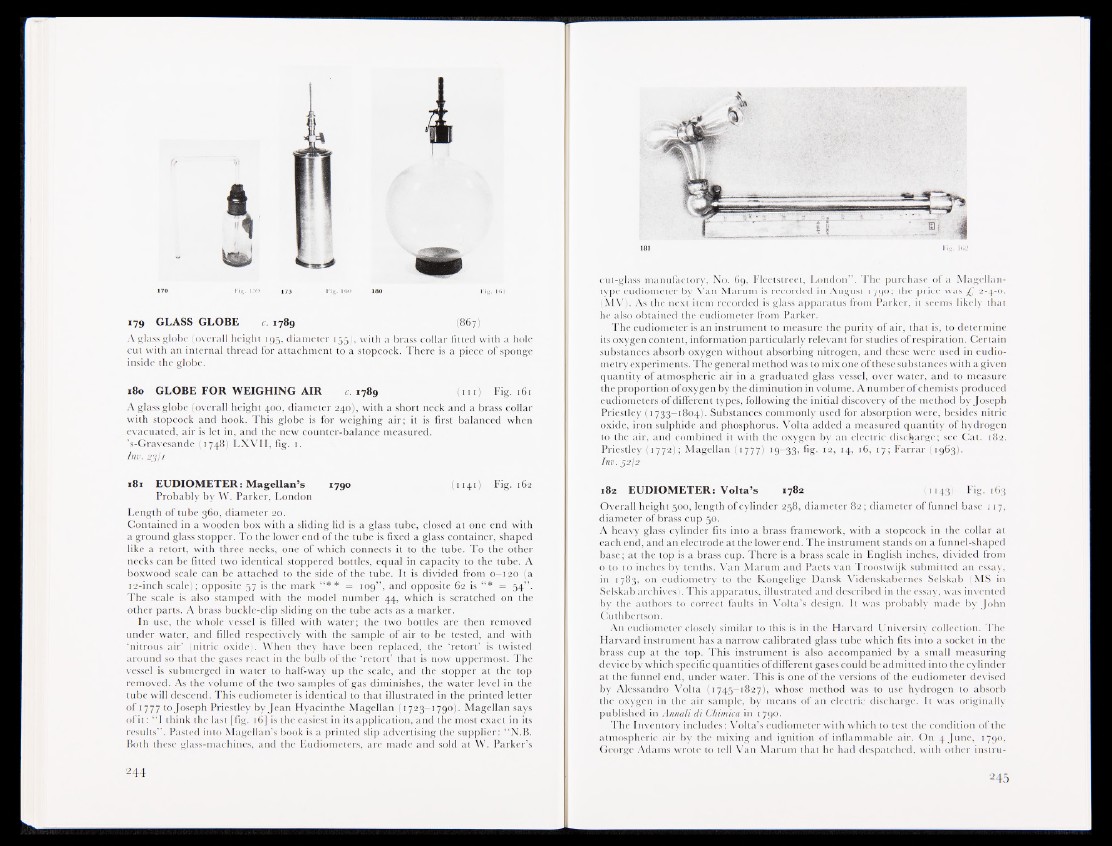
170 rig. 159 173 Fig. 160 180 Fig. 161
179 GLASS GLOBE c. 1789 (867)
A glass globe (overall height 195, diameter 155), with a brass collar fitted with a hole
cut with an internal thread for attachment to a stopcock. There is a piece of sponge
inside the globe.
180 GLOBE FOR WEIGHING AIR c. 1789 (m)I Fig. 161
A glass globe (overall height 400, diameter 240), with a short neck and a brass collar
with stopcock and hook. This globe is for weighing air; it is first balanced when
evacuated, air is let in, and the new counter-balance measured.
’s-Gravesande (1748) LXVII, fig. 1.
Inv. 2311
181 EUDIOMETER: Magellan’s 1790 (1141J Fig- 162
Probably by W. Parker, London
Length of tube 360, diameter 20.
Contained in a wooden box with a sliding lid is a glass tube, closed at one end with
a ground glass stopper. To the lower end of the tube is fixed a glass container, shaped
like a retort, with three necks, one of which connects it to the jtSube. To the other
necks can be fitted two identical stoppered bottles, equal in capacity to the tube. A
boxwood scale can be attached to the side of the tube. It is divided from 0—120 (a
12-inch scale); opposite 57 is the mark “ ** B 109” , and opposite 62 is “ * H 54” .
The scale is also stamped with the model number 44, which is scratched on the
other parts. A brass buckle-clip sliding on the tube acts as a marker.
In use, the whole vessel is filled with water; the two bottles are then removed
under water, and filled respectively with the sample of air to be tested, and with
"nitrous air’ (nitric oxide). When they have been replaced, the ‘retort’ is twisted
around so that the gases react in the bulb of the ‘retort’ that is now uppermost. The
vessel is submerged in water to half-way up the scale, and the stopper at the top
removed. As the volume of the two samples of gas diminishes, the water level in the
tube will descend. This eudiometer is identical to that illustrated in the printed letter
of 1777 to Joseph Priestley by Jean Hyacinthe Magellan (1723—1790® Magellan says
ofit: "I think the last [fig. 16] is the easiest in its application, and the most exact in its
results” . Pasted into Magellan’s book is a printed slip advertising the supplier: “N.B.
Both these glass-machines, and the Eudiometers, are made and sold at W. Parker’s
cut-glass manufactory, No. 69, Fleetstreet, London” . The purchase of a Magellan-
type eudiometer by Van Marum is recorded in August 1790; the price was £ 2-4-0.
(MV). As the next item recorded is glass apparatus from Parker, it seems likely that
he also obtained the eudiometer from Parker.
The eudiometer is an instrument to measure the purity of air, that is, to determine
its oxygen content, information particularly relevant for studies of respiration. Certain
substances absorb oxygen without absorbing nitrogen, and these were used in eudio-
metry experiments. The general method was to mix one of these substances with a given
quantity of atmospheric air in a graduated glass vessel, over water, and to measure
the proportion of oxygen by the diminution in volume. A number of chemists produced
eudiometers of different types, following the initial discovery of the method by Joseph
Priestley (1733—1804). Substances commonly used for absorption were, besides nitric
oxide, iron sulphide and phosphorus. Volta added a measured quantity of hydrogen
to the air, and combined it with the oxygen by an electric discharge; see Cat. 182.
Priestley (1 772); Magellan (17771,19 33, bg- 12, 14, 16, 17; Farrar (1963).
Inv. 5212
182 EUDIOMETER: Volta’s 1782 (1143) Fig. 163
Overall height 500, length of cylinder 258, diameter 82; diameter of funnel base 117,
diameter of brass cup 50.
A heavy glass cylinder fits into a brass framework, with a stopcock in the collar at
each end, and an electrode at the lower end. The instrument stands on a funnel-shaped
base; at the top is a brass cup. There is a brass scale in English inches, divided from
o to 10 inches by tenths. Van Marum and Paets van Troostwijk submitted an essay,
in 1783, on eudiometry to the Kongelige Dansk Videnskabernes Selskab (MS in
Selskab archives). This apparatus, illustrated and described in the essay, was invented
by the authors to correct faults in Volta’s design. It was probably made by John
Cuthbertson.
An eudiometer closely similar to this is in the Harvard University collection. The
Harvard instrument has a narrow calibrated glass tube which fits into a socket in the
brass cup at the top. This instrument is also accompanied by a small measuring
device by which specific quantities ofdifferent gases could be admitted into the cylinder
at the funnel end, under water. This is one of the versions of the eudiometer devised
by Alessandro Volta (1745—1827), whose method was to use hydrogen to absorb
the oxygen in the air sample, by means of an electric discharge. It was originally-
published in Annali di Chimica in 1790.
The Inventory includes: Volta’s eudiometer with which to test the condition of the
atmospheric air by the mixing and ignition of inflammable air. On 4 June, 1790,
George Adams wrote to tell Van Marum that he had despatched, with other instru